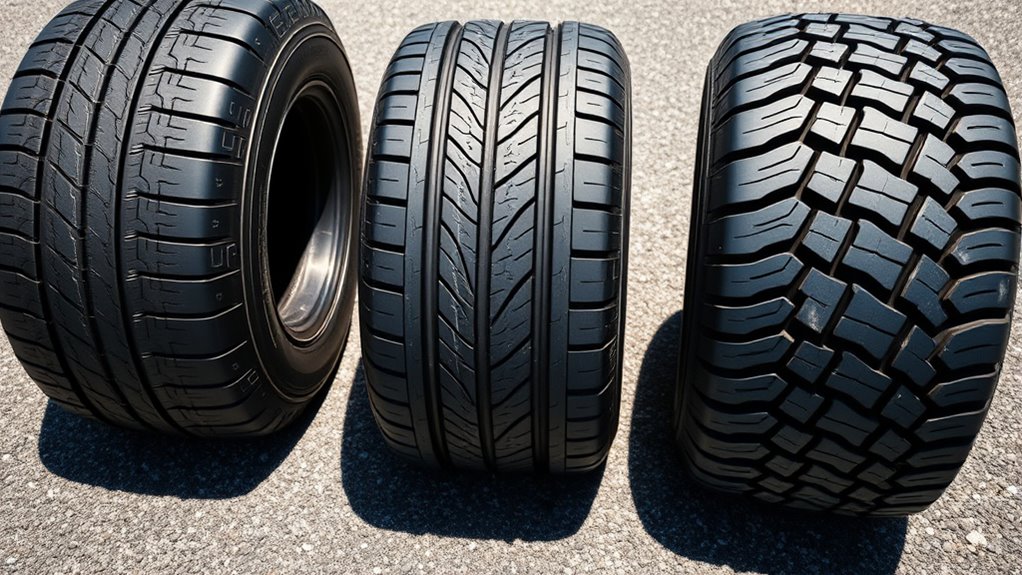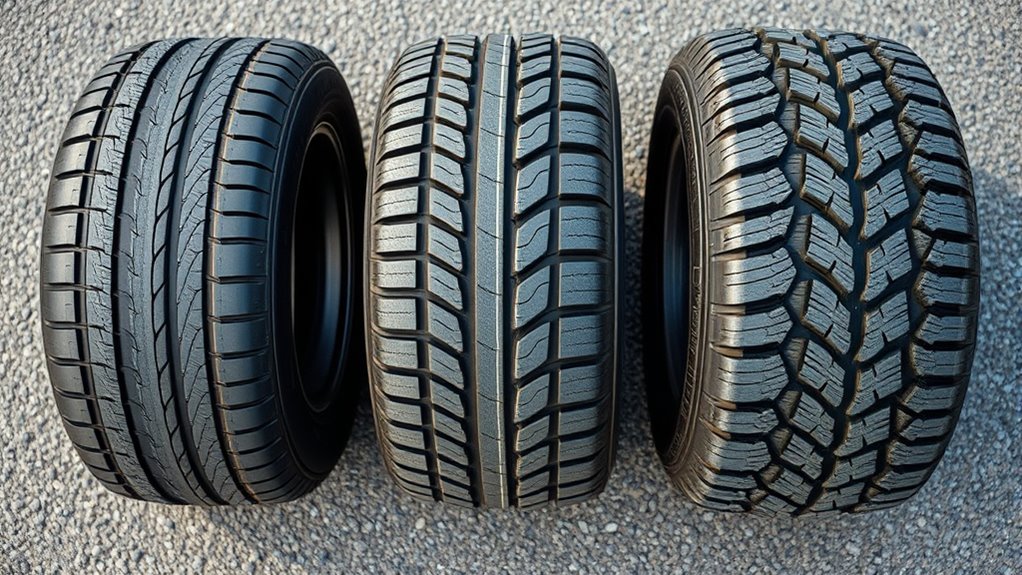Choosing the right tires depends on your climate and driving needs. All-season tires work well year-round, handling light snow, rain, and dry roads. Summer tires are best for warm, dry conditions, offering maximum grip and performance. Winter tires are designed for cold weather, snow, and ice, providing better traction and safety. Understanding these differences helps you stay safe and get better performance. Keep going to explore how each type can suit your driving habits and conditions.
Key Takeaways
- All-season tires offer balanced performance in various conditions, while summer tires excel in warm, dry environments and winter tires are suited for cold, snowy, and icy roads.
- Tire tread patterns and rubber compounds vary: all-season tires have siped treads for light snow, summer tires focus on grip and stability, winter tires feature deeper treads and softer rubber for snow and ice.
- Proper tire choice enhances safety, handling, and braking; selecting the right type depends on climate and driving needs.
- Summer tires are optimized for high-speed stability and wet traction on hot roads, whereas winter tires are tested for snow and ice grip.
- Understanding tire design, safety standards, and weather suitability helps make informed decisions for vehicle safety and performance.

Ever wonder how different tire types affect your vehicle’s performance and safety? The answer lies in understanding the unique design features and manufacturing processes behind all-season, summer, and winter tires. During tire manufacturing, manufacturers focus on meeting strict tire safety standards to guarantee each tire performs at its best under specific conditions. These standards set the benchmark for tread design, rubber compounds, and durability, helping you choose the right tires for your driving needs.
Understanding tire design and safety standards helps improve vehicle performance and safety across different weather conditions.
All-season tires are designed to provide a balance of performance across a variety of weather conditions. They’re made with compounds that remain flexible in moderate cold and warm temperatures, allowing for decent traction year-round. Their tread patterns are engineered to handle light snow, rain, and dry roads, making them versatile. Because they’re meant to serve multiple seasons, they often feature siping—small slits in the tread—that improve grip on wet surfaces. During tire manufacturing, great care is taken to ensure these tires meet tire safety standards for traction, braking, and longevity, giving you confidence in their performance through changing weather. Proper tire selection can also contribute to overall vehicle safety and efficiency, especially when considering factors like proper maintenance.
Summer tires, on the other hand, are enhanced for warm and dry conditions. They’re crafted with rubber compounds that maximize grip and handling on hot pavement, delivering superior steering response and braking performance. Summer tires typically feature less aggressive tread patterns, focusing on maximum contact with the road to enhance cornering and stability. Their design excludes deep grooves or extensive siping, which are less effective in cold or snowy environments. During manufacturing, these tires are rigorously tested to confirm they meet tire safety standards for high-speed stability and wet traction, making them ideal for sunny, dry, or mildly rainy conditions but unsuitable for winter weather.
Winter tires are specialized for cold temperatures and snow or ice. They incorporate softer rubber compounds that stay flexible in freezing weather, maintaining traction when other tires harden and lose grip. The tread patterns on winter tires are deeper and feature unique siping designed to bite into snow and ice, providing enhanced grip where all-season and summer tires falter. The manufacturing process for winter tires emphasizes durability and traction in harsh conditions while adhering to tire safety standards that guarantee performance in winter environments. These tires are essential for safe driving on icy or snowy roads, preventing slips and skids.
Understanding these differences helps you select the right tire type for your climate and driving style. When choosing, consider how tire manufacturing and tire safety standards influence performance and safety. Properly matched tires not only improve your vehicle’s handling but also boost safety, ensuring you’re prepared for the specific conditions you face on the road.
Frequently Asked Questions
How Do I Know When to Replace My Tires?
You’ll want to replace your tires when you notice your tread depth is below 2/32 inch, which diminishes grip and safety. Regularly check for uneven wear and perform tire rotations every 5,000 to 7,000 miles to promote even tread wear. Also, look for cracks, bulges, or embedded objects. When these signs appear, it’s time for new tires to guarantee safe driving.
Can I Use All-Season Tires in Extreme Winter Conditions?
Imagine waking up to a surprise snowstorm, and your all-season tires hit the road. While they offer decent tire durability and road handling in moderate winter, they’re not designed for extreme conditions. You risk reduced grip and safety. In severe winter weather, it’s best to switch to winter tires for peak performance and peace of mind, especially if you frequently face icy or snowy roads.
Are Winter Tires Worth the Investment in Mild Climates?
In mild climates, winter tires might seem unnecessary, but they can offer better tire durability and safety during occasional cold snaps. While they cost more upfront, they’re more cost-effective long-term if you experience icy or snowy conditions. If your winters are generally mild, you could skip them, but investing in winter tires guarantees safer driving and protects your vehicle when cold weather hits unexpectedly.
How Do Tire Treads Differ Among All-Season, Summer, and Winter Tires?
Imagine different tread designs as unique dance partners, each suited for specific conditions. All-season tires blend grip patterns for versatile performance, with moderate tread depth and siping. Summer tires feature fewer grooves, optimizing contact and grip on dry roads. Winter tires have deeper tread design and aggressive siping, providing better grip in snow and ice. Your choice depends on your climate, but understanding these tread differences helps you select the right partner for the road.
What Are the Environmental Impacts of Different Tire Types?
You should consider the environmental impacts of different tire types. Summer tires typically have lower manufacturing emissions due to simpler compounds, but they wear faster. All-season tires balance performance and durability, yet still contribute to resource use. Winter tires, while essential for safety, often involve more complex manufacturing and may be harder to recycle. Participating in recycling programs reduces waste, and choosing eco-friendly tires minimizes overall environmental footprints.
Conclusion
Choosing the right tire is like picking the perfect pair of shoes for your journey—you need the right fit for the conditions. All-season tires offer versatility, summer tires excel in warm weather, and winter tires handle snow and ice. By understanding these differences, you guarantee safer, smoother rides no matter the season. Remember, your tires are your vehicle’s shoes—select wisely to keep you moving confidently through every adventure.









